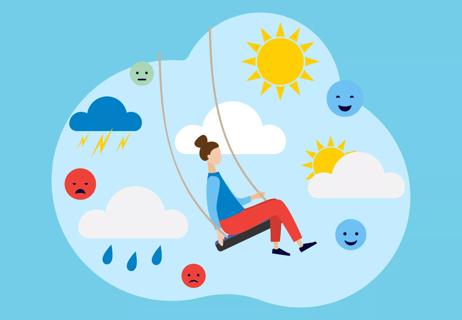How to see past outdated, prevailing attitudes and views

We live in an era where we talk openly about mental health issues more than ever before. We talk about the need to take mental health seriously and the best ways to treat it, be it medication, therapy or self-care.
Advertisement
Cleveland Clinic is a non-profit academic medical center. Advertising on our site helps support our mission. We do not endorse non-Cleveland Clinic products or services. Policy
And, yet, not everyone feels that way. Despite openness from many, there still exists a stigma around the topic of mental health that prevents many from acknowledging the effects of mental health and potential treatments.
With 1 in 5 Americans facing mental health issues each year, it’s important to understand where this stigma comes from and how we can push back against it. We talked to psychiatrist Douglas McLaughlin, DO, about the history of the stigma around mental health and what can be done to scale it back.
It’s important, Dr. McLaughlin says, to understand the history of how the world has viewed mental health when thinking about the stigma surrounding it.
“Culture and society has always been fascinated by mental health,” he points out. “There are so many books on this topic and those who dealt with issues: composers, artists, even whole books that put Shakespeare’s plays and characters in the context of mental health.
But despite that interest, people with mental health issues didn’t always receive the care they needed. “We mistreated people, we misunderstood people and we didn’t have good treatment options,” says Dr. McLaughlin.
It’s only been over the last few decades that we’ve gained a better understanding of mental health, better treatment options and more people getting well, making it easier to talk about.
Advertisement
One big obstacle to better understanding mental health and, therefore, breaking down the stigma has to do with the unknown. “Mental health is this cauldron of unknown conditions,” Dr. McLaughlin says.
When a reason behind a certain mental health condition is pinpointed, he says, whether it’s a hormonal imbalance or a thyroid dysfunction, the responsibility is passed on to a specialist, leaving mental health providers sometimes in this zone of unknowns.
And those unknowns can carry over to insurance companies which can add to the existing stigma, he says. “These unknowns are difficult concepts for insurance companies to measure and track. It makes it difficult for them to embrace the concept of conceptualizing a payment model and what outcome measures should be.”
Another reason that a stigma surrounding mental health persists is the corresponding health problems that often accompany certain conditions. People don’t want to have mental health issues, Dr. McLaughlin says, making it more likely they avoid it or slip into denial. “The life expectancy of a patient with a serious, chronic mental health issue can be 10 to 20 years shorter,” he points out.
“There’s more impairment across the board for them with other comorbidities,” he says. “Many patients with serious and chronic mental health disorders tend to smoke and have higher rates of cardiovascular and metabolic disorders.”
Compounding matters are insurance costs, he adds, noting that people who deal with these issues are more likely to under-report their conditions out of fear of costs and rising rates.
A big part of turning back the stigma of mental health is awareness, both big and small. From widespread information to even the simple words we choose to use can make a big difference.
“One of the big things people can do is talk about it,” says Dr. McLaughlin. “Sharing that mental health is common, that it’s treatable and that there are resources helps people understand. Organizations like the National Alliance on Mental Illness, the National Association of Social Workers, the American Psychiatric Association and the American Psychological Association are good resources for support, information and treatment.”
“People need to know that there’s hope and help because it ties into the past, why people didn’t talk about it. There weren’t good options like there are now,” he adds.
How we talk about mental health is also hugely important. “When I talk about mental health, I use the phrase ‘mental health’ instead of ‘mental illness,’” says Dr. McLaughlin.
He says it’s important to make sure people with these conditions don’t equate themselves with their illness. “Instead of saying ‘I’m bipolar’ or ‘I’m schizophrenic,’ you say that you have a medical condition.”
Advertisement
Another key to fighting the stigma of mental health is learning the full circle of how mental health issues can affect a person and understanding that those issues are manageable.
When people see a noteworthy person or celebrity publicly dealing with mental health issues, Dr. McLaughlin says, it’s often when they’re struggling with the most difficult aspects of their condition. “When people see that,” he says, “they don’t want to associate themselves with that behavior. There’s a hierarchy of what conditions and symptoms people are willing to accept when it comes to their own mental health.”
It’s a chronic cycling condition, he says, and it’s manageable but too often people only see the negative side of these conditions. It’s important to understand the full cycle, the times of recovery and clarity.
Because of these lingering stigmas, too, it can be difficult for those who are dealing with the negative parts of these conditions to accept that they need help. And that’s where family and friends can offer support to them, says Dr. McLaughlin.
“Talking to them is important, telling them you notice a change in their routine, in their behavior,” he says. “Enlightening them is important because when people are symptomatic, their insight and awareness can be impaired. Helping them understand that there are resources to help and it’s okay to talk about it is key.”
Advertisement
Patience is also important, he adds. “You have to have a lot of tolerance for mental health. Sometimes patients or family members just don’t have that tolerance or compassion. There are a lot of difficulties with some of these conditions that you need to be able to see through to get to the core of the treatment.”
Finally, everyone should remember that the opportunity to get help for mental health can greatly improve their quality of life. And even in the worst moments of battling with their conditions, it’s not permanent.
“I often remind patients that most of their lives, they haven’t haven’t been this profoundly affected by this mental health condition, whatever the condition is. The majority of their life has been a more symptom-free place.
Symptoms come and go, he says, but they won’t last forever. “If you’re having, you know, a crying spell, that’s what’s happening right now. But, most likely, you’re not going to be crying all day, every day. It comes and goes.”
Ultimately, he says, treatment of mental health conditions continues to improve. “It’s a challenge, but we are absolutely coming along. People are having better outcomes and shorter hospital stays and we’re able to get people stable faster. So that’s a hopeful message.”
Advertisement
Learn more about our editorial process.
Advertisement

Fishing for compliments, provoking conflict and pouring on the melodrama are all ways of expressing an unmet need

By setting boundaries around how much you give, you can save your time and resources while also being a good person

Certain B vitamins, omega-3 fatty acids and a healthy diet can serve as complementary treatments for schizophrenia

Following your treatment plan, finding a community, staying active and maintaining a healthy diet can help manage this psychiatric condition

Whether it’s playing hooky or faking cancer, malingering behavior is always motivated by personal gain

Causes range from psychological conditions like PTSD to physical conditions like fibromyalgia

Always putting others’ happiness before your own can build resentment over time

Emotional changes, isolation and unusual behavior could signal the onset of the condition

Start having sex about 72 hours before ovulation, then at least every other day during your fertile window

Attachment theory suggests that your earliest relationships shape connections throughout your life

It isn’t a recognized mental health disorder, but research shows that problematic social media use can negatively affect your mental health, self-esteem and sleep